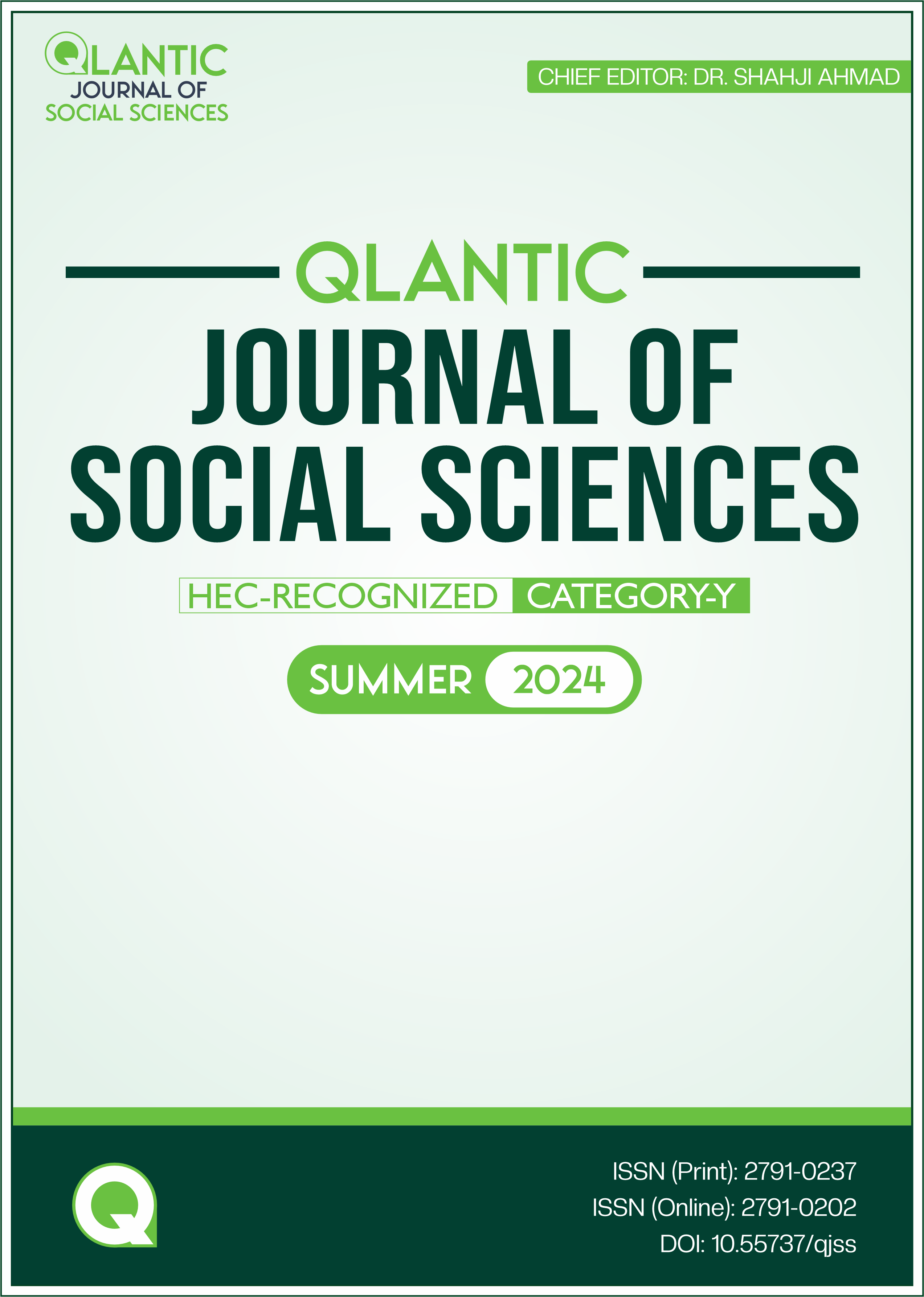Assessing Secondary School Teachers' Disaster Preparedness Using the Pakistan School Safety Framework and Sustainable Development Goals
DOI:
https://doi.org/10.55737/qjss.559757526Keywords:
Pakistan School Safety Framework, Disaster Preparedness, ustainable Development Goals, Secondary School Teachers, Disaster TrainingAbstract
In response to the potential risks posed by natural or human-made disasters, the Pakistan School Safety Framework (PSSF) was created to serve as a comprehensive strategy aimed at safeguarding the well-being of students, teachers, and school staff. A study was undertaken to evaluate the readiness of secondary school teachers in the face of disasters, utilizing the Sustainable Development Goals and the Pakistan School Safety Framework as guiding principles. An assessment questionnaire comprising 27 items aligned with the Sustainable Development Goals (SDGs) was meticulously developed and scrutinized by three subject matter experts before implementation for data gathering. The assessment tool encompassed four variables and a total of 27 items. Data was collected from 64 schools and 320 secondary school instructors and was subsequently analyzed using SPSS and Microsoft Excel. The results revealed that the majority of schools fell into the "Slightly Prepared" category based on the assessment outcomes. Following the study, the researcher provided recommendations to enhance disaster preparedness among secondary school teachers. These included the implementation of regular drills, provision of training sessions, and updating of emergency response plans. Moreover, the researcher emphasized the significance of collaboration with local emergency services and community organizations to bolster preparedness efforts and ensure a coordinated response in the event of a disaster.
Downloads
References
Alhadi, Z., Mandaita, F., & Yusran, R. (2021). Effectiveness of the Padang Pariaman Disaster Emergency Preparedness Program. Sumatra Journal of Disaster, Geography and Geography Education, 5(1), 59-62. https://doi.org/10.24036/sjdgge.v5i1.372
Anderson, B. (2020). The effects of the disaster. Political Geography, 78, 102172. https://doi.org/10.1016/j.polgeo.2020.102172
Aronsson-Storrier, M., & Dahlberg, R. (2022). Defining disaster: Disciplines and domains. Edward Elgar Publishing.
Azhar, A. (2022). Disaster Management Reforms in Pakistan. In Public Sector Reforms in Pakistan (pp. 329–348). Springer International Publishing. https://doi.org/10.1007/978-3-030-96825-0_14
Caldera, H. J., & Wirasinghe, S. C. (2021). A universal severity classification for natural disasters. Natural Hazards, 111(2), 1533-1573. https://doi.org/10.1007/s11069-021-05106-9
Chaudhary, M. T., & Piracha, A. (2021). Natural disasters—Origins, impacts, management. Encyclopedia, 1(4), 1101–1131. https://doi.org/10.3390/encyclopedia1040084
Crawford, P. A., & Roberts, S. K. (2018). Literature as support: Using picturebooks to assist young children in coping with natural disasters and human crises. In Assisting Young Children Caught in Disasters (pp. 171–180). Springer International Publishing. https://doi.org/10.1007/978-3-319-62887-5_16
Cvetković, V. M., Renner, R., Lukić, T., & Aleksova, B. (2024). Geospatial and temporal patterns of natural and man-made (technological) disasters (1900-2024): Insights from different perspectives. In Preprints. https://doi.org/10.20944/preprints202408.0175.v1
Gaillard, J. C. (2019). Disaster studies inside out. Disasters, 43 Suppl 1(S1), S7–S17. https://doi.org/10.1111/disa.12323
Khan, I., Ali, A., Waqas, T., Ullah, S., Ullah, S., Shah, A. A., & Imran, S. (2022). Investing in disaster relief and recovery: A reactive approach of disaster management in Pakistan. International Journal of Disaster Risk Reduction, 75, 102975. https://doi.org/10.1016/j.ijdrr.2022.102975
Masten, A. S. (2020). Resilience of children in disasters: A multisystem perspective. International Journal of Psychology, 56(1), 1-11. https://doi.org/10.1002/ijop.12737
Rahman, A., Khan, A. N., & Shaw, R. (2015). Disaster risk reduction approaches in Pakistan. Springer.
Rosalie, B., & Ronquillo. (2020). Teachers’ Preparedness on Disaster Risk Reduction and Management Measures among Public Senior High Schools in the Division of Batangas City. International Journal of Innovative Science and Research Technology, 05(12). https://doi.org/10.47191/ijsshr/v6-i1-99
Rosselló, J., Becken, S., & Santana-Gallego, M. (2020). The effects of natural disasters on international tourism: A global analysis. Tourism Management, 79, 104080. https://doi.org/10.1016/j.tourman.2020.104080
Seddighi, H., Sajjadi, H., Yousefzadeh, S., López López, M., Vameghi, M., Rafiey, H., Khankeh, H. R., & Garzon Fonseca, M. (2020). Students’ preparedness for disasters in schools: A systematic review protocol. BMJ Paediatrics Open, 4(1), e000913. https://doi.org/10.1136/bmjpo-2020-000913
Shah, I., Elahi, N., Alam, A., Dawar, S., & Dogar, A. A. (2020). Institutional arrangement for disaster risk management: Evidence from Pakistan. International Journal of Disaster Risk Reduction, 51, 101784. https://doi.org/10.1016/j.ijdrr.2020.101784
Shah, S. S., Rana, I. A., & Ali, A. (2023). Multi-hazard risk perception: An empirical study of the remote Gilgit city, Hindukush-Karakorum-Himalayan (HKH) region, Pakistan. International Journal of Disaster Risk Reduction, 96, 103996. https://doi.org/10.1016/j.ijdrr.2023.103996
Shiwaku, K., Ueda, Y., Oikawa, Y., & Shaw, R. (2016). School disaster resilience assessment: An assessment tool. Disaster Risk Reduction, 105-130. https://doi.org/10.1007/978-4-431-55982-5_8
Tin, D., Cheng, L., Le, D., Hata, R., & Ciottone, G. (2024). Natural disasters: A comprehensive study using EMDAT database 1995–2022. Public Health, 226, 255-260. https://doi.org/10.1016/j.puhe.2023.11.017
Tuladhar, G., Yatabe, R., Dahal, R. K., & Bhandary, N. P. (2015). Disaster risk reduction knowledge of local people in Nepal. Geoenvironmental Disasters, 2(1). https://doi.org/10.1186/s40677-014-0011-4
Published
Issue
Section
License
Copyright (c) 2024 Shahid Iqbal, Saeed Ahmed Abro, Tehseen Anjum, Ishfaq Ahmed

This work is licensed under a Creative Commons Attribution-NonCommercial 4.0 International License.




